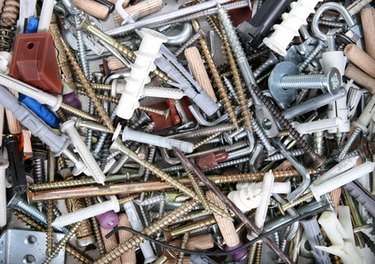
People have been building furniture with dowels and screws for many years. In the beginning, dowels were all they used. Today, screws have become more convenient and faster. Some woodworkers still prefer the old-fashioned holding power of dowels, and in many instances, dowels are the only way to go. But in a production-oriented society, screws are more often the choice of manufacturers.
How Screws Work
Video of the Day
Screws work with spiral cutting threads that pull two pieces of wood together without the aid of clamps. Clamping force is developed as the builder applies torque to the screw head. Screws are fast and convenient. For this reason alone, screws are used more often than dowels.
Video of the Day
How Dowels Work
Dowels work by binding two pieces of wood together with an adhesive under pressure from clamps. Holes are drilled in two individual pieces of wood, with the dowel passing through both pieces of wood, connecting them together. Dowels take time to align and dry. Dowels can be very time consuming in their application but are considered more exclusive.
Dowel Strength
Dowel joinery is stronger than screw joinery. The increased glue surface caused by the glue deeply penetrating the wood gives the dowel more holding power. The clamp and dry method used in dowel construction ensures that the joint is sufficiently set before the next step in building the item is taken. Dowels also have superior holding power in modern composite materials such as particleboard and plywood. Screws will easily strip out in these materials, while dowels will not strip when the doweled joint is allowed to set up with glue.
Screw Advantages
Screws do have advantages. Screws are much smaller, can be put in at odd angles and into tight spaces, and can be added to a project afterward when more strength is needed. Screws can also be removed from a project if the application is crooked or becomes loose. Screws can be backed out, realigned, replaced and retightened. Dowels are permanent.
Application Is the Key
Dowels and screws have different applications. In fine furniture, dowels are superior to screws. Dowels can be hidden inside the wood, and the heads of dowels, when exposed and sanded flush, can be almost invisible when the dowel wood is the same type as the entire project. In cabinet and production woodworking, screws are a better choice, their versatility and speed being the key for manufacturers.